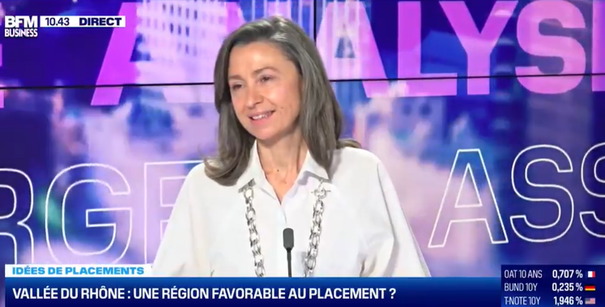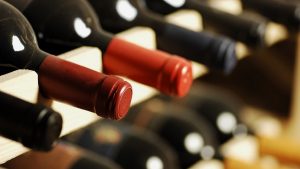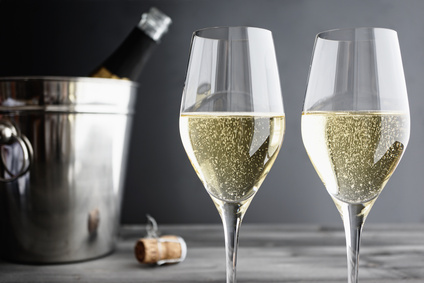
In Angélique de Lencquesaing’s latest interview for BFM’s investment segment, she talked to Cédric Decoeur about the market for fine wine from the Rhône Valley. Based on last year’s auction results, then, how much space should the Rhône be given in your cellar?
Cédric Decoeur: You’re currently writing iDealwine’s Barometer of wine auction results, a project that involves identifying the biggest trends in the market. But today we’re not looking at the eternal battle of Burgundy vs Bordeaux, we’re here to talk about the Rhône Valley.
A.de L. : Yes, I often end up talking about Bordeaux and Burgundy since they each take up so much space on the auction market. At iDealwine, 41% of the bottles auctioned in 2021 were from Bordeaux, and 38% from Burgundy.
So where does the Rhône sit?
Wines from the Rhône represented 12% of our auction sales last year, which amounts to a bit more than 23,000 bottles. As you can tell, that gives us plenty to work from in terms of analysis.
Is this a stable proportion from one year to the next? Because we can’t say the same of Burgundy or Bordeaux…
That’s right, Bordeaux’s percentage has been gradually chipped away by other regions in recent years, whilst Burgundy just doesn’t stop growing. The volume of wine from the Rhône valley sold last year dropped by 13% whilst the overall value increased by 6%. The result of this has been a jump in average bottle price for the region, reaching €137 at auction. But be careful, this development is a bit of an illusion.
What do you mean by that?
Just a handful of wines caused this average price hike for the Rhône wines auctioned last year. And even within that small number, there’s one particular name that stands out, Château Rayas, an estate in Châteauneuf-du-Pape that has seen its price skyrocket on the market, especially at the end of the year.
Is it just Château Rayas that’s performing like this, or do the rest of Emmanuel Reynaud’s wines have the same effect?
It’s true that Emmanuel Reynaud crafts wines from a variety of different parcels, from ‘simple’ Côtes-du-Rhône plots at Château des Tours to the highly renowned Châteauneuf-du-Pape of Château Rayas. I have to say, it is just the latter that has shot up in value, particularly the red cuvées which have seen their average price leap from €668 to €1,276 in just one year, a 91% increase.
The wines from this producer weigh heavy on the region’s results then?
Well, 14% of the Rhône wines auctioned last year via iDealwine were produced by Emmanuel Reynaud, which is clearly huge for one wine maker. The general value increase of 78% for his domain can explain, on its own, the increased average bottle price in the region. Looking at the numbers, if we remove Château Rayas from the figures, the Rhône’s average hammer price goes from €137 to €103. So there’s no doubt about the impact of this estate.
So he’s the only one to have such an effect on the region’s results?
No, there’s actually another star estate worth mentioning, this one in the north of the Rhône Valley, and that’s Jean-Louis Chave. This understated vintner is dedicated to rehabilitating the slopes of Saint-Joseph, and he’s particularly known for his Hermitage cuvées; these are sought-after across the world. These auction results also contributed to the region’s overall performance for the year.
Do you sell lots of Jean-Louis Chave cuvées at iDealwine?
In 2021, the number of Chave bottles up for auction dropped significantly from 2,006 to 798. At the same time, the estate’s average bottle price leapt by 67%! These results have put Domaine Chave in second place for the region’s best-selling property. Thus, if we remove this domain from the Rhône’s results, we see the average bottle price drop yet again to €87.
At these prices, is it worth investing in these estates or is it better to look elsewhere?
There are two things to mention here. Firstly, Emmanuel Reynaud and Jean-Louis Chave have become icons of the Rhône Valley, and collectors all around the world are seeking these bottles for their cellars. It is true, though, that these names have a tendency to hide the region’s other top names. Since the latter remain at a more accessible level, they provide great opportunities for creating a collection.
Where are the best opportunities, north or south?
In the northern Rhône we find appellations like Hermitage, Côte-Rôtie, and Cornas, and prices here are higher so your choice might be budgetary more than anything. Guigal is a northern icon known to many, but other signatures we’ve seen perform well of late include Benetière, Levet, Steohan and Gangloff.
Are there any northern domains for smaller investment budgets?
Yes, it’s interesting to look at Saint-Joseph and Crozes-Hermitage, where I really recommend Domine Pierre Gonon and Domaine Coursodon respectively.
In the south of the region, Châteauneuf is the most renowned appellation…and the most expensive?
Renowned, definitely, although the variety of estates and prices is immense! There are some really exciting wines from domains like Pierre André, Les Cailloux, Clos des Papes, Beaurenard, and Saint-Préfert.
And what about more affordable wines?
It’s good to look into the surrounding appellations that are less in the limelight, such as Vacqueyras (Roucas Toumba, La Monardière) and Gigondas (La Bouïssière). It’s also worth considering the Côtes du Rhône villages appellations, particularly Cairanne where we find Oratoire Saint-Martin and Richaud.
In terms of investment, one of the best features of Rhône wine is its great ageing potential. In fact, half of the Rhône bottles auctioned in 2021 were in vintages over ten years old, demonstrating their capacity to age well and gain in value over time.
You can browse our Rhône wines here



